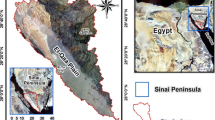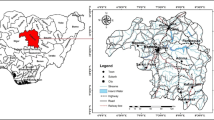Abstract
Groundwater development across much of sub-Saharan Africa is constrained by a lack of knowledge on the suitability of aquifers for borehole construction. The main objective of this study was to map groundwater potential at the country-scale for Ghana to identify locations for developing new supplies that could be used for a range of purposes. Groundwater potential zones were delineated using remote sensing and geographical information system (GIS) techniques drawing from a database that includes climate, geology, and satellite data. Subjective scores and weights were assigned to each of seven key spatial data layers and integrated to identify groundwater potential according to five categories ranging from very good to very poor derived from the total percentage score. From this analysis, areas of very good groundwater potential are estimated to cover 689,680 ha (2.9 % of the country), good potential 5,158,955 ha (21.6 %), moderate potential 10,898,140 ha (45.6 %), and poor/very poor potential 7,167,713 ha (30 %). The results were independently tested against borehole yield data (2,650 measurements) which conformed to the anticipated trend between groundwater potential and borehole yield. The satisfactory delineation of groundwater potential zones through spatial modeling suggests that groundwater development should first focus on areas of the highest potential. This study demonstrates the importance of remote sensing and GIS techniques in mapping groundwater potential at the country-scale and suggests that similar methods could be applied across other African countries and regions.











Similar content being viewed by others
References
Asomaning, G. (1993). Groundwater resources of the Birim basin in Ghana. Journal of African Earth Sciences (and the Middle East), 15(3-4), 375–384. no. 3–4.
CIAWF. (2010). Ghana Economy 2010 (http://www.theodora.com/wfbcurrent/ghana/ghana_economy.html).
CSIR/WRI. (2003). Groundwater assessment: an element of integrated water resources management—the case of Densu River Basin, July 2003. http://www.wrc-gh.org/nationalwaterpolicy.html.
ERDAS. (2007). ERDAS field guide, Volume 1, October 2007.
ESRI. (2009). ESRI Field Guide, Volume 1, October 2009.
FAO. (2005). Aquastat, FAO water report 29, 2005. http://www.fao.org/nr/water/aquastat/countries/ghana/index.stm.
GIDA. (2000). Annual report. Ghana: Ghana Irrigation Development Authority.
GIDA. (2001). General information on public irrigation projects in Ghana. Ghana: Ghana Irrigation Development Authority.
Gill, H. E. (1969). A ground-water reconnaissance of the Republic of Ghana, with a description of geohydrologic provinces. US Geological Survey water-supply paper 1757-K (pp. 1–37). Washington, DC: US Geological Survey.
Giordano, M. (2006). Agricultural groundwater use and rural livelihoods in sub-Saharan Africa: a first-cut assessment. Hydrogeology Journal, 14(3), 310–318. no. 3.
Gumma, M. K., Thenkabail, P. S., Fujii, H., & Namara, R. (2009). Spatial models for selecting the most suitable areas of rice cultivation in the Inland Valley Wetlands of Ghana using remote sensing and geographic information systems. Journal of Applied Remote Sensing, 3, 033537.
Gumma, M. K., Thenkabail, P. S., & Barry, B. (2010). Delineating shallow groundwater irrigated areas in the Atankwidi watershed (northern Ghana, Burkina Faso) using Quickbird 0.61–2.44 meter data. African Journal of Environmental Science and Technology, 4(7), 455–664. no. 7.
Gumma, M. K., Thenkabail, P. S., Hideto, F., Nelson, A., Dheeravath, V., & Busia, D. (2011). Mapping irrigated areas of Ghana using fusion of 30 m and 250 m resolution remote-sensing data. Remote Sensing, 3(4), 816–835.
Hellden, U., Olsson, L., & Stern, M. (1982). Approaches to desertification monitoring in Sudan. In L. G. Lery (Ed.), Satellite remote sensing in developing counties (pp. 131–144). Paris: European Space Agency.
Hsin, F. Y., Cheng, H. L., Kuo, C. H., & Change, P. H. (2008). GIS for assessment of the groundwater recharge potential. Environmental Geology, 58, 185–195.
ICHS (Inter-African Committee for Hydraulic Studies). (1986). Explanatory notice and recommended usage of the map of potential groundwater resources in western and central Africa 1:5,000,000. Orléans: ICHS, BRGM.
ISSER. (2002). The state of the Ghanaian economy. Ghana: The Institute of Statistical, Social and Economic Research (ISSER), University of Ghana.
Kamaraju, M. V. V., Bhattacharya, A., Sreenivasa, R., Chandrasekhar, R., Murthy, G. S., & Malleswara Rao, T. C. H. (1996). Ground-water potential evaluation of West Godavari district, Andhra Pradesh State, India—a GIS approach. Ground Water, 34, 318–325.
Kumar, A., & Srivastava, S. K. (1991). Geomorphological unit, their geohydrological characteristics and vertical electrical sounding response near Mungre, Bhihar. J. Indian Society of Remote Sensing, 19(4), 205–215.
Kumar, P. K. D., Gopinath, G., & Seralathan, P. (2007). Application of remote sensing and GIS for the demarcation of groundwater potential zones of a river basin in Kerala, southwest coast of India. International Journal of Remote Sensing, 28(24), 5583–5601.
Kushwaha, S. P. S. (1993). Application of remote sensing in shifting cultivation areas. Technical report (pp. 23–28). Freiburg: Abteilung Luftbildmessung and Fernerkundung, Universitat Freiburg.
Lamptey, N.L. (2006). Urban poverty reduction project launched. Daily Graphic, 4-3-06, p. 18
MacDonald, A.M. and Davies, J. (2000). A brief review of groundwater for rural water supply in sub-Saharan Africa. British Geological Survey technical report WC/00/33.
MacDonald, A.M., R.C. Calow, A.L. Nicol, B. Hope, and N.S. Robins. (2001). Ethiopia: water security and drought. British Geological Survey technical report WC/01/02.
Martin, N., & van de Giesen, N. (2005). Spatial distribution of groundwater production and development potential in the Volta river basin of Ghana and Burkina Faso. Water International, 30(2), 239–249.
Masiyandima, M., & Giordano, M. (2007). Sub-Saharan Africa: opportunistic exploitation. In M. Giordano & K. Villholth (Eds.), The agricultural groundwater revolution: opportunities and threats to development (pp. 79–99). Wallingford: CABI.
Mattikalli, H. M., Devereux, B. J., & Richards, K. S. (1995). Integration of remote sensed satellite images with a geographical information system. Computers and Geosciences, 21, 947–956.
Murthy, K. S. R. (2000). Groundwater potential in a semi-arid region of Andhra Pradesh—a geographical information system approach. International Journal of Remote Sensing, 21(9), 1867–1884.
Murthy, K. S. R., & Mamo, A. G. (2009). Multi-criteria decision evaluation in groundwater zones identification in Moyale-Teltele subbasin, South Ethiopia. International Journal of Remote Sensing, 30(11), 2729–2740.
Nag, S. K. (2005). Application of lineament density and hydrogeomorphology to delineate groundwater potential zones of Baghmundi block in Purulia district, West Bengal. Journal of Indian Society of Remote Sensing, 33(4), 521–529.
Ngigi, S. N. (2009). Climate change adaptation strategies: water resources management options for smallholder farming systems in sub-Saharan Africa. New York: The MDG Centre for East and Southern Africa, The Earth Institute at Columbia University. 189p.
NRSA (National Remote Sensing Agency). (2000). Methodology manual of ground water prospective zone maps. Rajiv Gandhi National Rural Drinking Water Mission, technical guidelines for preparation of ground water prospects maps (pp. 17–18). Hyderabad: Department of Space.
Quansah, C. (2000). Country case study: Ghana. In FAO: integrated soil management for sustainable agriculture and food security FAO-RAF 2000/01, Accra, pp. 33–75.
Rashid, M., M. Lone, and S. Ahmed. (2011). Integrating geospatial and ground geophysical information as guidelines for groundwater potential zones in hard rock terrains of south India. Environmental Monitoring and Assessment, 184, 4829–4839.
Saraf, A. K., & Chowdhury, E. (1998). Integrated remote sensing and GIS for groundwater exploration and identification of artificial recharge sites. International Journal of Remote Sensing, 19(10), 1825–1841.
Sidhu, R.S., and Mehta, R.S. (1989). Delineation of groundwater potential zones in Kushawati river watershed a tributary of Zauri river in Goa, using remotely sensed data. In Proceedings of National Symposium on Engineering Applications of Remote Sensing and Recent Advantages, Indore (M.P), India, pp. 41–46.
Smith, A. Y., & Blackwell, R. J. (1980). Development of an information data base for watershed monitoring. Photogrammetric Engineering & Remote Sensing, 46, 1027–1038.
Subba Rao, N. (2006). Groundwater potential index in a crystalline terrain using remote sensing data. Environ. Geology, 50, 1067–1076.
Subba Rao, N. (2009). A numerical scheme for groundwater development in a watershed basin of basement terrain: a case study from India. Hydrology Journal, 17, 379–396.
Thenkabail, P. S., Smith, R. B., & De Pauw, E. (2000). Hyperspectral vegetation indices and their relationships with agricultural crop characteristics. Remote Sensing of Environment, 71(2), 158–182.
Thenkabail, P. S., Enclona, E. A., Ashton, M. S., Legg, C., & De Dieu, M. J. (2004). Hyperion, IKONOS, ALI, and ETM+ sensors in the study of African rainforests. Remote Sensing of Environment, 90(1), 23–43.
Titus, R., H. Beekman, S. Adams, and L. Strachan. (2009). The basement aquifers of Southern Africa. Water Research Commission report no. TT 428-09.
Trotter, C. M. (1991). Remotely sensed data as information source for geographical information system in natural resources management: a review. International Journal of Remote Sensing, 5, 225–239.
WHYMAP. (2008). Groundwater resources of the world. BGR/UNESCO. Accessed at: http://www.whymap.org.
Woodford, A., P. Rosewarne, and J. Girman. (2006). How much groundwater does South Africa have? Accessed at: www.srk.co.uk/groundwater/PDFs/1_A_Woodford.pdf.
Acknowledgments
This study was financially supported by the Rockefeller Foundation through project number 2008-AGR-305 “Groundwater in sub-Saharan Africa: Implications for food security and livelihoods” as a part of the CGIAR Research Program on Climate Change, Agriculture and Food Security. The authors would like to sincerely thank Dr. Mehnaz for generating the geomorphology map and Dr. Emmanuel Obuobie (CSIR—Water Research Institute) and Mr. Gerald Forkuor (IWMI) for data provision and peer review of this work. We are grateful to the Geological Survey Department of Ghana for access to the soils, geology, and watershed boundary data that enabled this research to proceed. The lead author would like to also thank Dr. Andrew Nelson and Dr. Alice Laborte (IRRI) for their encouragement during the latter stages of the research.
Author information
Authors and Affiliations
Corresponding author
Rights and permissions
About this article
Cite this article
Gumma, M.K., Pavelic, P. Mapping of groundwater potential zones across Ghana using remote sensing, geographic information systems, and spatial modeling. Environ Monit Assess 185, 3561–3579 (2013). https://doi.org/10.1007/s10661-012-2810-y
Received:
Accepted:
Published:
Issue Date:
DOI: https://doi.org/10.1007/s10661-012-2810-y




